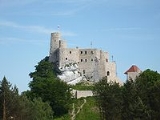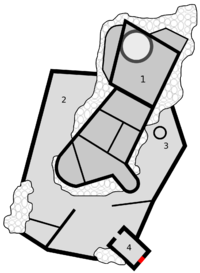
Bobolice Castle
Encyclopedia
The Bobolice Castle – a royal castle built in the middle of the 14th century in the Polish Jura, in the village of Bobolice.
. In 1370, immediately after becoming King of Poland, Louis I the Great granted the castle to Władysław Opolczyk, Duke of Opole, as a prize for his support of the king’s dynastic plans. Nine years later Opolczyk leased the castle to Andrzej Schoen, a Hungarian from Barbalas; the new owner manned it with Germans and Czechs, who robbed local inhabitants and conspired with the Teutonic Order
. Dissatisfied with their behaviour, the Polish king Władysław Jagiełło
invaded Bobolice in 1396 and took over the castle with adjacent estates. From that time on, the stronghold was owned by a number of families, including Szafrańcowie, Trestkowie, Krezowie (Ostoja coat of arms; owners from 1486) and later Chodakowscy, Męcińscy and Myszkowscy (Jastrzębiec coat of arms; owners of the neighbouring Mirów Castle
).
According to 15th century chronicles, a representative of the Krezowie family captured and imprisoned his niece in the Bobolice Castle. She is still said to haunt the stronghold as a lady in white. There is also a tale about two twin brothers, owners of castles in Mirów and Bobolice. Legend has it that they dug a tunnel between the two strongholds so that they could often meet tête à tête. One day they came into possession of a big treasure – they hid it in the tunnel and put an odious-looking witch on guard to deter any potential thieves. The brothers understood each other perfectly and could go through fire and water for each other. However, their friendship was put to a difficult test, when one brother brought a beautiful girl from his war expedition. Suspecting that his twin brother may have fallen in love with the girl, he locked her in the cellar near the treasure. One day, during the absence of the witch, who was attending a witches’ sabbath at the Bald Mount, he caught the pair of lovers in the vault. He got angry, murdered his brother and bricked up the girl in the castle dungeons. The ghost of the girl is still said to haunt the castle tower.
 The beginning of the decline of the castle dates back to 1587, when it was heavily devastated during the invasion of Maximilian III, Archduke of Austria, a rival of Sigismund III Vasa
The beginning of the decline of the castle dates back to 1587, when it was heavily devastated during the invasion of Maximilian III, Archduke of Austria, a rival of Sigismund III Vasa
to the Polish throne. The castle was reconstructed by the then owners, the Krezowie family, but in 1657, during the Deluge, it was plundered and totally ruined by Swedish troops. The condition of the stronghold was so bad that when King John III Sobieski
arrived here in 1683, he had to spend the night in a tent.
In the 19th century a huge treasure was found in stronghold cellars. It is supposed that its part may be stored in the legendary tunnel between Bobolice and Mirów. In 1882, after parcelling out the land, the already deserted walls were acquired by the peasant family of Baryłów. Now the castle belongs to the Lasecki family, who decided to rebuild it in 1999.
). Up till now, only the upper part of the stronghold (the residential building with at least two storeys and remnants of the cylindrical wall tower) has survived. The castle was accessible through a drawbridge
over the dry moat
, and the entire construction was surrounded by walls with battlement
s, made of local white limestone
. Currently reconstruction works are under way in order to restore the entrance gate and the circumferential wall around the castle grounds.
History
The castle in Bobolice was built by King Casimir III the Great in the middle of the 14th century, probably in place of an earlier wooden structure. The castle was a part of the defence system of royal strongholds protecting the western border of Poland on the side of SilesiaSilesia
Silesia is a historical region of Central Europe located mostly in Poland, with smaller parts also in the Czech Republic, and Germany.Silesia is rich in mineral and natural resources, and includes several important industrial areas. Silesia's largest city and historical capital is Wrocław...
. In 1370, immediately after becoming King of Poland, Louis I the Great granted the castle to Władysław Opolczyk, Duke of Opole, as a prize for his support of the king’s dynastic plans. Nine years later Opolczyk leased the castle to Andrzej Schoen, a Hungarian from Barbalas; the new owner manned it with Germans and Czechs, who robbed local inhabitants and conspired with the Teutonic Order
Teutonic Knights
The Order of Brothers of the German House of Saint Mary in Jerusalem , commonly the Teutonic Order , is a German medieval military order, in modern times a purely religious Catholic order...
. Dissatisfied with their behaviour, the Polish king Władysław Jagiełło
Jogaila
Jogaila, later 'He is known under a number of names: ; ; . See also: Jogaila : names and titles. was Grand Duke of Lithuania , king consort of Kingdom of Poland , and sole King of Poland . He ruled in Lithuania from 1377, at first with his uncle Kęstutis...
invaded Bobolice in 1396 and took over the castle with adjacent estates. From that time on, the stronghold was owned by a number of families, including Szafrańcowie, Trestkowie, Krezowie (Ostoja coat of arms; owners from 1486) and later Chodakowscy, Męcińscy and Myszkowscy (Jastrzębiec coat of arms; owners of the neighbouring Mirów Castle
Mirów Castle
Mirów Castle is a 14th century castle, now ruined, located in the Mirów village, Silesian Voivodeship, Poland. It changed owners multiple times, and was finally abandoned in 1787....
).
According to 15th century chronicles, a representative of the Krezowie family captured and imprisoned his niece in the Bobolice Castle. She is still said to haunt the stronghold as a lady in white. There is also a tale about two twin brothers, owners of castles in Mirów and Bobolice. Legend has it that they dug a tunnel between the two strongholds so that they could often meet tête à tête. One day they came into possession of a big treasure – they hid it in the tunnel and put an odious-looking witch on guard to deter any potential thieves. The brothers understood each other perfectly and could go through fire and water for each other. However, their friendship was put to a difficult test, when one brother brought a beautiful girl from his war expedition. Suspecting that his twin brother may have fallen in love with the girl, he locked her in the cellar near the treasure. One day, during the absence of the witch, who was attending a witches’ sabbath at the Bald Mount, he caught the pair of lovers in the vault. He got angry, murdered his brother and bricked up the girl in the castle dungeons. The ghost of the girl is still said to haunt the castle tower.

Sigismund III Vasa
Sigismund III Vasa was King of Poland and Grand Duke of Lithuania, a monarch of the united Polish–Lithuanian Commonwealth from 1587 to 1632, and King of Sweden from 1592 until he was deposed in 1599...
to the Polish throne. The castle was reconstructed by the then owners, the Krezowie family, but in 1657, during the Deluge, it was plundered and totally ruined by Swedish troops. The condition of the stronghold was so bad that when King John III Sobieski
John III Sobieski
John III Sobieski was one of the most notable monarchs of the Polish–Lithuanian Commonwealth, from 1674 until his death King of Poland and Grand Duke of Lithuania. Sobieski's 22-year-reign was marked by a period of the Commonwealth's stabilization, much needed after the turmoil of the Deluge and...
arrived here in 1683, he had to spend the night in a tent.
In the 19th century a huge treasure was found in stronghold cellars. It is supposed that its part may be stored in the legendary tunnel between Bobolice and Mirów. In 1882, after parcelling out the land, the already deserted walls were acquired by the peasant family of Baryłów. Now the castle belongs to the Lasecki family, who decided to rebuild it in 1999.
Architecture
The castle is situated on a steep rocky hill (360 m above sea levelAbove mean sea level
The term above mean sea level refers to the elevation or altitude of any object, relative to the average sea level datum. AMSL is used extensively in radio by engineers to determine the coverage area a station will be able to reach...
). Up till now, only the upper part of the stronghold (the residential building with at least two storeys and remnants of the cylindrical wall tower) has survived. The castle was accessible through a drawbridge
Drawbridge
A drawbridge is a type of movable bridge typically associated with the entrance of a castle surrounded by a moat. The term is often used to describe all different types of movable bridges, like bascule bridges and lift bridges.-Castle drawbridges:...
over the dry moat
Moat
A moat is a deep, broad ditch, either dry or filled with water, that surrounds a castle, other building or town, historically to provide it with a preliminary line of defence. In some places moats evolved into more extensive water defences, including natural or artificial lakes, dams and sluices...
, and the entire construction was surrounded by walls with battlement
Battlement
A battlement in defensive architecture, such as that of city walls or castles, comprises a parapet , in which portions have been cut out at intervals to allow the discharge of arrows or other missiles. These cut-out portions form crenels...
s, made of local white limestone
Limestone
Limestone is a sedimentary rock composed largely of the minerals calcite and aragonite, which are different crystal forms of calcium carbonate . Many limestones are composed from skeletal fragments of marine organisms such as coral or foraminifera....
. Currently reconstruction works are under way in order to restore the entrance gate and the circumferential wall around the castle grounds.

